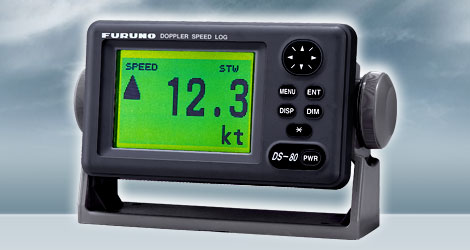The Doppler speed log is an instrument used to meausure the speed of the vessel or boat.
The speed log is based on measurement of the Doppler effect that is, the difference between the acoustic signal transmit by the ship and the receiver return signal after reflection on the bottom of the sea.
The shift in frequency is proportional to the speed of movement of the transmitter .

The Doppler log uses the sea bottom as the reflector, but clearly the ship is not moving towards the sea bottom .
To obtain the best result the angle of the aucusti signal emaned must be stetted in a forward direction with an angle of 30 deg to the vertical.
The angle between the horizontal plane and the transmission must now be applied to the basic Doppler shift formula .
Fd = 2V x Ft x Cosine ө / C in HRZ , Cosine ө = 0.5 ,Fd = V.Ft / C
Page Contents
EFFECT ON MEASURE FOR DOPPLER SPEED LOG
Vertical movement of the ship, the effects of pitching and changing trim can all largely be accounted for by having not just a single beam pointing forward but by also having a second beam pointing astern at the same angle.
Most Doppler log transmit the energy in a pulse form rather than continuous wave.
This means that one transducer can be used as both transmitter and receiver .
The beam is about 3º wide and the frequency is in the region of 100 – 600 KHZ.
GROUND SPEED AND WATER SPEED

In depths greater than 200m the return echo is too weak to be useful and the Doppler log will no longer give ground speed .
The water layers at 10 – 30 meters below the keel also cause an echo and Doppler effect, this is used to give the value of the speed relative to the water.
It is also known as water track, while the the other one bottom track.
The doppler speed log automatically Shift to this mode when ground contact is lost.
When there is a changing on the mode an indication on display is also visible.
Certain Doppler log are dual axis, i . e they also have two beams in a ransverse axis so that lateral speed can also be measured.
This can be particularly useful in the docking of tanker.
Environmental factors affecting the accuracy of speed logs :
unfortunately environmental factors can introduce errors and/ or produce sporadic indications in any system that relies for its operation on the transmission and reception of acoustic waves in salt water.
- water clarity. in exceptional cases the purity of the seawater may lead to insufficient scattering of the acoustic energy and prevent an adequate signal return. it is not likely to be a significant factor because most seawater holds the suspended particles and micro-organisms that adequately scatter an acoustic beam.
- aeration. aerated water bubbles beneath the transducer face may reflect acoustic energy of sufficient strength to be interpreted erroneously as sea bottom returns producing inaccurate depth indications and reduced speed accuracy. To reduce the aeration effect the transducer of the doppler log is sitted away from bow thrusters.
- vessel trim and list. a change in the vessel’s trim from the calibrated normal will affect fore/aft speed indication and an excessive list will affect athwart ship speed. a janus configuration transducer reduces this error .
- ocean current profile. this effect is prevalent in areas with strong tides or ocean currents. in the water track mode. a speed log measures velocity relative to multiple thermo cline layers several feet down in the water. if these layers are moving in opposite directions to the surface water. an error may be introduced.
- sea state : in rough sea condition the error in the measuring are maximum due to the ships moving and to aeration that will generate the sea.
CONCLUSION
The doppler speed log is an important instrument on board of every ship and boat. Before to use as for every instrument onboard a ship or boat is foundamental to know the how it works.
Read also : Speed of a cruise ship



